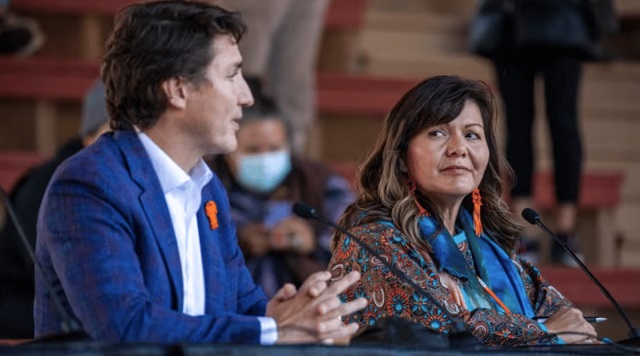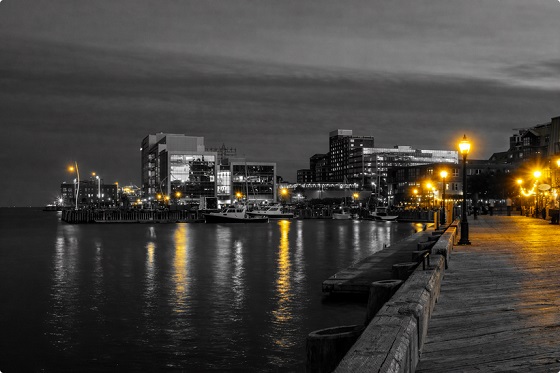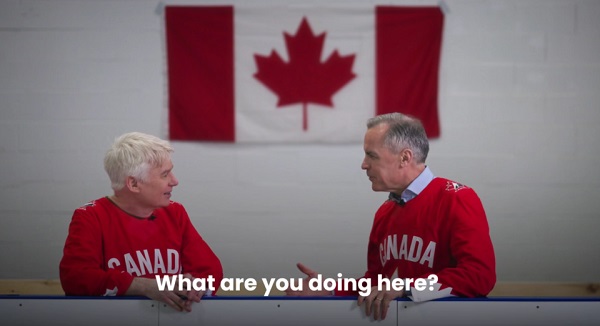Frontier Centre for Public Policy
Why is Trudeau sticking to the unmarked graves falsehood?

From the Frontier Centre for Public Policy
There is simply no possibility that Trudeau didn’t know on June 17th, 2024 that he was spreading misinformation when he said that unmarked graves were found. In plain English — he knew he was lying.
The claim made by Chief Rosanne Casimir on May 27th, 2021, that the remains of 215 children, former students of the Kamloops Indian Residential School (KIRS) had been found in unmarked graves on the school grounds, was false.
Only soil anomalies were detected by a radar device. Those anomalies could be tree roots, previous excavations, or almost anything. In fact, research since that time makes it clear that the anomalies were almost certainly the trenches of a former septic field installed in 1924 to dispose of the school’s sewage.
No “unmarked graves”, “human remains”, “bodies” or “mass graves” were found.
Chief Casimir finally confessed to making that false claim three years after making it. She admitted what was known to most of all along: no graves, human remains, or bodies were found — only 215 “anomalies”.
So, everyone in Canada now knows that the May 27th, 2021 claim of unmarked graves containing human remains found at Kamloops was false. Everybody except the prime minister it seems, and his former Indigenous Affairs Minister, Marc Miller.
However on June 17th, 2024, Prime Minister Trudeau — instead of taking the opportunity to set the record straight — repeated at an indigenous event the whopper that “unmarked graves” have been found. He has been spreading that misinformation for three years.
One would think that now that the person who originally made the false claim has admitted that no graves were found — only anomalies — that Trudeau would take the opportunity to clear up the confusion and go with the truth, instead of repeating the original lie.
There is simply no possibility that Trudeau didn’t know on June 17th, 2024 that he was spreading misinformation when he said that unmarked graves were found. In plain English — he knew he was lying.
So, why would he do such a thing? Doesn’t a prime minister have a duty to refrain from deliberately lying to Canadian citizens? After all, the great majority of Canadians know by now that no graves were found at Kamloops.
The only answer that makes sense is that the Prime Minister was not speaking to all Canadians on June 17th, 2024. He was speaking only to indigenous Canadians when he falsely stated that unmarked graves had been found at Kamloops. He was repeating a lie they believed. They believed that lie in large part because he and Marc Miller were doing their best to keep the lie alive.
Everything that he and his colleagues have done since May 27, 2021 — lowering flags, kneeling with a teddy bear in an ordinary community cemetery, lavishing money on indigenous communities to search for missing children he knows were never “missing” — has been done to pander to an indigenous community that largely believes those false stories about evil priests and secret burials. I repeat — believes that anti- Catholic bilge in large part because the Trudeau Liberals have encouraged them to believe it.
What has come to be known as the “Kamloops Graves Hoax” is now known to most Canadians for what it is — a false claim. However, we have a prime minister who, for his own reasons, seems intent on keeping the hoax going within the indigenous community. The deception being practiced by the prime minister will have serious consequences in the years ahead. And those consequences are all negative.
Prime ministers come and go. Some remain popular throughout their term, but some become increasingly unpopular. For example, the late Brian Mulroney was so unpopular with Canadians toward the end of his term that the Conservatives, led by his successor, Kim Campbell, were virtually wiped in the election following his retirement.
Trudeau’s fate remains to be seen.
However, that is just politics. But what Trudeau is doing, in deliberately lying to an already marginalized demographic that has a history of being lied to by indigenous and non-indigenous politicians, is not just politics. It is reprehensible conduct. Those people are going to be very angry when they realize that they have been deceived.
Under Trudeau’s watch, we have already seen churches burn, statues topple, and other mayhem as a result of a claim that the PMO knows is false.
Exactly why he is practicing this deception we do not know. We do know with certainty that Indigenous Affairs Minister Marc Miller spoke with Chief Rosanne Casimir on the evening of May 27, 2021, immediately after she made her false claim that the remains of 215 children, who were students at KIRS, had been found. Here’s what he said about his May 27, 2021 telephone conversation with Casimir, according to Hansard:
“On Thursday evening, I spoke to Chief Casimir and assured her of my steadfast support for the grieving and reconciliation process over the coming weeks. We have been in contact since then as well. We will be there with them as they lead this initiative, and we will help meet their needs in the coming weeks and months.”
Unless Chief Casimir told Miller that “remains” had been found, and not the truth — that only anomalies had been detected — the Trudeau government and the Kamloops band together, for reasons unknown, created the false narrative that the remains of 215 children had been found, knowing that their claim was false. Why did this happen?
The prime minister is now keeping this false narrative alive, knowing that it was, and is, false. Why is he doing this?.
And why are the CBC and our mainstream media not even trying to find out?
Something is very wrong here.
Brian Giesbrecht, retired judge, is a Senior Fellow at the Frontier Centre for Public Policy
Business
The Real Reason Canada’s Health Care System Is Failing

From the Frontier Centre for Public Policy
By Conrad Eder
Conrad Eder supports universal health care, but not Canada’s broken version. Despite massive spending, Canadians face brutal wait times. He argues it’s time to allow private options, as other countries do, without abandoning universality.
It’s not about money. It’s about the rules shaping how Canada’s health care system works
Canada’s health care system isn’t failing because it lacks funding or public support. It’s failing because governments have tied it to restrictive rules that block private medical options used in other developed countries to deliver timely care.
Canada spends close to $400 billion a year on health care, placing it among the highest-spending countries in the Organization for Economic Co-operation and Development (OECD). Yet the system continues to struggle with some of the longest waits for care, the fewest doctors per capita and among the lowest numbers of hospital beds in the OECD. This is despite decades of spending increases, including growth of 4.5 per cent in 2023 and 5.7 per cent in 2024, according to estimates from the Canadian Institute for Health Information.
Canadians are losing confidence that government spending is the solution. In fact, many don’t even think it’s making a difference.
And who could blame them? Median health care wait times reached 30 weeks in 2024, up from 27.7 weeks in 2023, which was up from 27.4 weeks in 2022, according to annual surveys by the Fraser Institute.
Nevertheless, politicians continue to tout our universal health care system as a source of national pride and, according to national surveys, 74 per cent of Canadians agree. Yet only 56 per cent are satisfied with it. This gap reveals that while Canadians value universal health care in principle, they are frustrated with it in practice.
But it isn’t universal health care that’s the problem; it’s Canada’s uniquely restrictive version of it. In most provinces, laws restrict physicians from working simultaneously in public and private systems and prohibit private insurance for medically necessary services covered by medicare, constraints that do not exist in most other universal health care systems.
The United Kingdom, France, Germany and the Netherlands all maintain universal health care systems. Like Canada, they guarantee comprehensive insurance coverage for essential health care services. Yet they achieve better access to care than Canada, with patients seeing doctors sooner and benefiting from shorter surgical wait times.
In Germany, there are both public and private hospitals. In France, universal insurance covers procedures whether patients receive them in public hospitals or private clinics. In the Netherlands, all health insurance is private, with companies competing for customers while coverage remains guaranteed. In the United Kingdom, doctors working in public hospitals are allowed to maintain private practices.
All of these countries preserved their commitment to universal health care while allowing private alternatives to expand choice, absorb demand and deliver better access to care for everyone.
Only 26 per cent of Canadians can get same-day or next-day appointments with their family doctor, compared to 54 per cent of Dutch and 47 per cent of English patients. When specialist care is needed, 61 per cent of Canadians wait more than a month, compared to 25 per cent of Germans. For elective surgery, 90 per cent of French patients undergo procedures within four months, compared to 62 per cent of Canadians.
If other nations can deliver timely access to care while preserving universal coverage, so can Canada. Two changes, inspired by our peers, would preserve universal coverage and improve access for all.
First, allow physicians to provide services to patients in both public and private settings. This flexibility incentivizes doctors to maximize the time they spend providing patient care, expanding service capacity and reducing wait times for all patients. Those in the public system benefit from increased physician availability, as private options absorb demand that would otherwise strain public resources.
Second, permit private insurance for medically necessary services. This would allow Canadians to obtain coverage for private medical services, giving patients an affordable way to access health care options that best suit their needs. Private insurance would enable Canadians to customize their health coverage, empowering patients and supporting a more responsive health care system.
These proposals may seem radical to Canadians. They are not. They are standard practice everywhere else. And across the OECD, they coexist with universal health care. They can do the same in Canada.
Alberta has taken an important first step by allowing some physicians to work simultaneously in public and private settings through its new dual-practice model. More Canadian provinces should follow Alberta’s lead and go one step further by removing legislative barriers that prohibit private health insurance for medically necessary services. Private insurance is the natural complement to dual practice, transforming private health care from an exclusive luxury into a viable option for Canadian families.
Canadians take pride in their health care system. That pride should inspire reform, not prevent it. Canada’s health care crisis is real. It’s a crisis of self-imposed constraints preventing our universal system from functioning at the level Canadians deserve.
Policymakers can, and should, preserve universal health care in this country. But maintaining it will require a willingness to learn from those who have built systems that deliver universality and timely access to care, something Canada’s current system does not.
Conrad Eder is a policy analyst at the Frontier Centre for Public Policy.
Business
Ottawa Is Still Dodging The China Interference Threat

From the Frontier Centre for Public Policy
By Lee Harding
Alarming claims out of P.E.I. point to deep foreign interference, and the federal government keeps stalling. Why?
Explosive new allegations of Chinese interference in Prince Edward Island show Canada’s institutions may already be compromised and Ottawa has been slow to respond.
The revelations came out in August in a book entitled “Canada Under Siege: How PEI Became a Forward Operating Base for the Chinese Communist Party.” It was co-authored by former national director of the RCMP’s proceeds of crime program Garry Clement, who conducted an investigation with CSIS intelligence officer Michel Juneau-Katsuya.
In a press conference in Ottawa on Oct. 8, Clement referred to millions of dollars in cash transactions, suspicious land transfers and a network of corporations that resembled organized crime structures. Taken together, these details point to a vulnerability in Canada’s immigration and financial systems that appears far deeper than most Canadians have been told.
P.E.I.’s Provincial Nominee Program allows provinces to recommend immigrants for permanent residence based on local economic needs. It seems the program was exploited by wealthy applicants linked to Beijing to gain permanent residence in exchange for investments that often never materialized. It was all part of “money laundering, corruption, and elite capture at the highest levels.”
Hundreds of thousands of dollars came in crisp hundred-dollar bills on given weekends, amounting to millions over time. A monastery called Blessed Wisdom had set up a network of “corporations, land transfers, land flips, and citizens being paid under the table, cash for residences and property,” as was often done by organized crime.
Clement even called the Chinese government “the largest transnational organized crime group in the history of the world.” If true, the allegation raises an obvious question: how much of this activity has gone unnoticed or unchallenged by Canadian authorities, and why?
Dean Baxendale, CEO of the China Democracy Fund and Optimum Publishing International, published the book after five years of investigations.
“We followed the money, we followed the networks, and we followed the silence,” Baxendale said. “What we found were clear signs of elite capture, failed oversight and infiltration of Canadian institutions and political parties at the municipal, provincial and federal levels by actors aligned with the Chinese Communist Party’s United Front Work Department, the Ministry of State Security. In some cases, political donations have come from members of organized crime groups in our country and have certainly influenced political decision making over the years.”
For readers unfamiliar with them, the United Front Work Department is a Chinese Communist Party organization responsible for influence operations abroad, while the Ministry of State Security is China’s main civilian intelligence agency. Their involvement underscores the gravity of the allegations.
It is a troubling picture. Perhaps the reason Canada seems less and less like a democracy is that it has been compromised by foreign actors. And that same compromise appears to be hindering concrete actions in response.
One example Baxendale highlighted involved a PEI hotel. “We explore how a PEI hotel housed over 500 Chinese nationals, all allegedly trying to reclaim their $25,000 residency deposits, but who used a single hotel as their home address. The owner was charged by the CBSA, only to have the trial shut down by the federal government itself,” he said. The case became a key test of whether Canadian authorities were willing to pursue foreign interference through the courts.
The press conference came 476 days after Bill C-70 was passed to address foreign interference. The bill included the creation of Canada’s first foreign agent registry. Former MP Kevin Vuong rightly asked why the registry had not been authorized by cabinet. The delay raises doubts about Ottawa’s willingness to confront the problem directly.
“Why? What’s the reason for the delay?” Vuong asked.
Macdonald-Laurier Institute foreign policy director Christopher Coates called the revelations “beyond concerning” and warned, “The failures to adequately address our national security challenges threaten Canada’s relations with allies, impacting economic security and national prosperity.”
Former solicitor general of Canada and Prince Edward Island MP Wayne Easter called for a national inquiry into Beijing’s interference operations.
“There’s only one real way to get to the bottom of what is happening, and that would be a federal public inquiry,” Easter said. “We need a federal public inquiry that can subpoena witnesses, can trace bank accounts, can bring in people internationally, to get to the bottom of this issue.”
Baxendale called for “transparency, national scrutiny, and most of all for Canadians to wake up to the subtle siege under way.” This includes implementing a foreign influence transparency commissioner and a federal registry of beneficial owners.
If corruption runs as deeply as alleged, who will have the political will to properly respond? It will take more whistleblowers, changes in government and an insistent public to bring accountability. Without sustained pressure, the system that allowed these failures may also prevent their correction.
Lee Harding is a research fellow for the Frontier Centre for Public Policy.
-

 Business2 days ago
Business2 days agoLand use will be British Columbia’s biggest issue in 2026
-

 Energy3 hours ago
Energy3 hours agoRulings could affect energy prices everywhere: Climate activists v. the energy industry in 2026
-

 Digital ID4 hours ago
Digital ID4 hours agoThe Global Push for Government Mandated Digital IDs And Why You Should Worry
-

 Bruce Dowbiggin3 hours ago
Bruce Dowbiggin3 hours agoThe Rise Of The System Engineer: Has Canada Got A Prayer in 2026?
-

 International1 day ago
International1 day agoTrump confirms first American land strike against Venezuelan narco networks
-

 International3 hours ago
International3 hours agoMaduro says he’s “ready” to talk
-

 Opinion2 days ago
Opinion2 days agoGlobally, 2025 had one of the lowest annual death rates from extreme weather in history
-

 Business1 day ago
Business1 day agoHow convenient: Minnesota day care reports break-in, records gone





